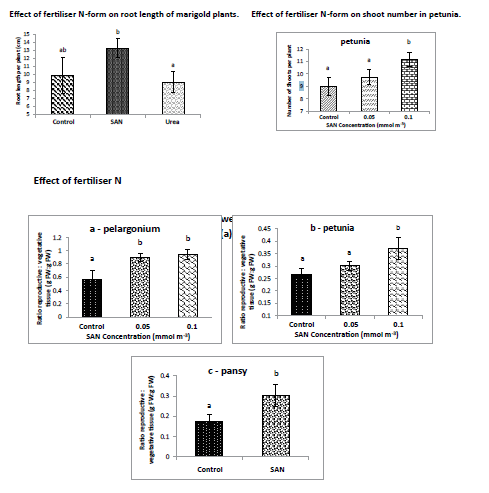Switching to a different form of applied nitrogen could increase grower profits, improve plant physiology and raise plants’ stress tolerance, according to new research
By Adrian Bell
The alternative nitrogen – a chemically stabilised form of urea – would also optimise resource use while helping to reduce the environmental impact of fertiliser manufacture, according to British firm Levity Crop Science, which carried out the study on a range of containerised ornamentals.
“Plant development altered favourably and improved several commercial attributes, such as more branches and flowers, while raising tolerance to stress caused by drought or transplantation,” says David Marks, one of the study’s co-authors.
The findings, published in the Journal of Horticulture and Postharvest Research, suggest growers could make more efficient use of nitrogen fertiliser and produce healthier, more desirable plants by applying it in a more accessible form.
“Mineral nitrogen – such as manufactured ammonium nitrate – has long been the ‘go to’ method of soil fertilisation,” says David, who is managing director of Levity Crop Science. “But it’s now understood that plants also make use of available organic nitrogen, rather than being totally reliant on inorganic nitrogen, and with this knowledge we have a renewed enthusiasm for improving fertiliser usage.
“Inorganic nitrogen production is not only inefficient but also environmentally costly. It produces greenhouse gases during manufacture and can have adverse effects on water systems after application,” he explains.
“On the other hand, urea – in common use as a primary nitrogen source – is soluble and susceptible to breakdown by an enzyme found in almost all soils,” he points out. “But one option is to coat urea granules with sulphur or polyurethane, a technique already proven.”
 Instead, the trio of researchers focused their work on an alternative, chemical method of stabilising urea-sourced amine in soil, which Levity has itself developed. The technology (known as LimiN) has already shown its ability to increase tuber yield in potato crops.
Instead, the trio of researchers focused their work on an alternative, chemical method of stabilising urea-sourced amine in soil, which Levity has itself developed. The technology (known as LimiN) has already shown its ability to increase tuber yield in potato crops.
“We were especially keen to investigate how ornamentals access and use nitrogen for improved hardiness and flower production,” says co-author Dr Sally Wilkinson, “particularly as we know that different nitrogen forms affect plant phenotype – the characteristics of a plant that are down to its environment, rather than its genetics.”
Pelargonium, petunia, pansy and French marigold were the four species used for the research.
Levity’s stabilised amine nitrogen (SAN) was compared with both standard urea and an industry standard NPK (IS), with amounts of all three carefully calculated to provide the plant with identical amounts of N. Adjustments were also made across the three treatments to ensure consistent access to sufficient micronutrients for the duration of the study.
Measurements were taken for leaf chlorophyll content; leaf length, width and area; lateral shoot count; floral bud and flower numbers; and root length. Tissue weights were also recorded at the end of the experiment.
In all four species, SAN increased the chlorophyll content compared to IS controls, while SAN increased leaf size in pelargonium and pansy. SAN increased branching in pelargonium, and shoot numbers in petunia, while marigolds displayed increased root length.
“Perhaps the most striking effect of SAN was in flower and floral bud numbers,” highlights Sally.
“SAN fertilisation increased numbers per plant by up to 130 per cent compared to IS controls in pelargonium, pansy and petunia, and by up to 40 per cent compared to urea in marigold.
“Meanwhile, reproductive tissue weight increased in SAN-treated plants, with pelargonium showing up to twice as much tissue, and petunia 25 per cent more than controls. In pansies, SAN increased flower weight by more than 100 per cent.”
Stabilised amine nitrogen improves a number of characteristics in ornamental plants, says David.
“Firstly, perhaps most importantly, SAN improves retail aesthetics. Nursery owners will recognise immediately the increased value in plants with more branches, more flowers and, thanks to more chlorophyll, greener leaves.
“But growers will also value plants with more roots, branches and chlorophyll for their reduced susceptibility to stress caused by transplantation and extremes of temperature or soil moisture.”
Behind the science, David says, SAN’s effectiveness is down to two main factors: loss and breakdown of standard nitrogen following application, and the greater availability of SAN to the plant.
“SAN is an organic nitrogen form, which places a lower energy and carbon demand on the plant,” he says. “That frees up more resource for photosynthesis, leaf growth, branching and root growth, and ultimately for reproductive development – the flowers.
“It’s a simple finding, but with important applications for many horticultural and agricultural crops reliant on applied nitrogen. Stabilised amine provides nitrogen with a lower environmental cost, while equipping plants to cope better with what’s expected to be an increasingly stressful climate.”
The full paper is published in Volume 2, issue 1 of the Journal of Horticulture and Postharvest Research.
About Levity Crop Science
Founded in 2011, Levity Crop Science is a British company that seeks to develop and commercialise sustainable agricultural products. Its definition of a sustainable product is one that improves crop production, reduces waste, increases yield and ultimately contributes to farmers’ profitability. Levity’s products are sold and used in countries around the world.
